
Being an effective and successful Scrum Master requires a wide variety of skills, knowledge, and experience. This variety is captured in the stances of a Scrum Master. The Scrum Master is expected to act as a teacher, impediment remover, facilitator, coach, mentor, and change agent. The Scrum Master does so by acting on 3 levels: Scrum Team, building relationships with others, and supporting the entire organization. Everything, with servant-leadership as the foundational mindset and attitude.
These days, becoming an effective and successful Scrum Master gets a whole new dimension. Due to the COVID-19 crisis, chances are that everyone in your organization is working from home. This includes your Product Owner and Development Team.
Working remotely requires you to rethink your role as a Scrum Master. What does remote facilitation look like? How can you coach remotely? How to discover any impediments? How to improve team dynamics? How to show servant-leadership and ‘read the room’ when you’re not physically present with the team?
In this blog post, we explore these questions by using the Scrum Master stances as a structure. In all honesty, although we do have lots of experience working remotely, being a remote Scrum Master is new for us as well. So we offer experiments, practices, and strategies that we used in different contexts and think are worth trying as a Scrum Master, working remotely.
“When working remotely, what experiments, practices, and strategies can you use, to become an effective and successful Scrum Master?”
Good to Know
The purpose of this blog post is to offer you tons of inspiration. The article contains many experiments, practices, and strategies you can try. It became a comprehensive article. To prevent it from being even longer, we don’t describe all the steps in detail. The experiments are connected to articles that do contain detailed information. We encourage you to use your imagination, creativity, and experimentation to figure out what works for you. In general, use these 10 tips to have productive and engaging virtual meetings.
The suggested experiments aren’t limited to be used remotely only. Hopefully, we quickly have the situation again where we can choose to use the ideas remote or in-person.
Remote Teaching
The Scrum Master as a teacher explains the purpose of the Scrum Framework, its theory, practices, rules, and values, and how it helps to be effective in complex environments. The Scrum Master approaches teaching as “the art of assisted discovery” rather than “presenting the facts”.

Things to try…
- Start a “Scrum Question of the Week” exercise. At the start of the week, you offer the team a question about the Scrum theory & principles. For example: what are the boundaries the Scrum Framework offers in which self-organization can occur? Encourage team members to discuss the question and capture their answers in a digital workspace/whiteboard like Mural, Miro, or InVision.
- Create a virtual Scrum Quiz. Think of funny, interesting, and surprising facts about Scrum, XP, Kanban, etc and create a quiz around it. There are plenty of free tools available to use. Ask everyone to do the quiz simultaneously and reward the winner with a nice price.
- Flip the teaching role. In your digital workspace, make a couple of posters available that capture elements of the Scrum framework. For example, a poster about Sprint Goals, the Definition of Done, or the Scrum Events. Invite everyone with Zoom and create breakout rooms. Assign one of the prepared Scrum sheets to each room. Give the small group time to prepare their 2-minute lecture. Together, give each group their teaching moment. Debrief together and add where necessary.
- Use the card game “40 seconds of Scrum” virtually. In 40 Seconds of Scrum, two teams compete against each by trying to guess as many terms from a card. One member of each team gets 40 seconds to try to explain the concepts on the card without mentioning them directly, while their team races to give the correct answers.
- Trigger valuable conversations with the “Scrum Mythbusters” card deck. Test your knowledge of the Scrum Framework with this deck of 22 ‘Scrum Mythbusters’-cards. Each card contains a statement about the Scrum Framework that is either true or false. Uncover misunderstandings of the principles & values behind the Scrum Framework and work together to correct them, and get more out of Scrum as a result.
- Start a virtual book club. With your Scrum Team or within the wider organization, start a book club. Pick a book, a blog post or a podcast to start with. Invite people in a way that emphasizes that participation is optional. Schedule a gathering with the purpose to gather useful insights and novel ideas from reading books, blog posts, and listening to podcasts.
Remote Impediment Removal
The Scrum Master as impediment remover supports the team in solving problems by themselves and resolves the problems that exceed the team's self-organizing capabilities.
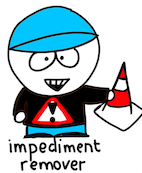
Things to try…
- Use the card deck “Management in Scrum” to make impediments transparent. Connect the cards with activities to the various roles. For example, who is responsible for releasing the product increment? What is the impact of working remotely on how work is managed and distributed? What’s different compared to Professional Scrum? What are impediments that need to be resolved?
- Share an impediment newsletter throughout the organization. When working remotely, digital communication becomes more important. Therefore, raise awareness about the biggest impediments, including their consequences and requests for help, in a format that you can easily distribute to everyone who has a stake in your work. It could be a mailing, a paper newsletter, or a blog post on your intranet.
- Create a virtual impediment board. Once you’ve identified the impediments, make them visible in a digital workspace. Instead of creating a physical impediment board, make it virtual. Encourage the team to resolve the impediments together. Therefore, update it during the Scrum Events and coach & mentor the team to support self-organization.
- Try “Discovery & Action Dialogue” to resolve impediments. Use this Liberating Structure to learn the team how to ask or write questions that include different perspectives, and to identify specific and actionable solutions. The Liberating Structure “Discovery and Action Dialogue” is ideal for this exploration. It contains a sequence of questions that teams can ask to understand the problem, come up with solutions, and specify steps that need to be taken.
- Use the Liberating Structure “Wise Crowds” to tackle persistent impediments with other Scrum Masters. Schedule a virtual meetup with the Scrum Masters in your organization. Ask everyone to bring their toughest impediments, preferably those that transcend a single team. In multiple rounds, the impediments are being shared by “clients” and the “consultants” (the other Scrum Masters) offer help.
Remote Coaching
The Scrum Master coaches team members with a focus on mindset and behavior, the Scrum Team in continuous improvement & working empirically, and the organization in how to effectively collaborate with the Scrum Team.
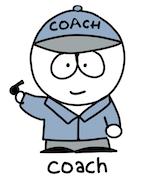
Things to try…
- Offer individual coaching sessions. Yes, an obvious practice for a coach. Approach everyone individually and make clear that if they’re struggling with challenges (e.g. caused by COVID-19), you are available for a voice or video call. Even if it’s simply to listen. As with coaching, emphasize the conversations will be confidential and non-judgemental.
- Use the Liberating Structure “TRIZ” during the Retrospective. Ask the Scrum Team “What can we do to guarantee, our remote way-of-working will be the worst experience ever?!” Invite the team to create a long list of wild ideas, help them reflect on the things they are already doing, and coach them on how to stop the unproductive behavior and activities.
- Coach the Product Owner. Working remotely can be a completely different experience for your Product Owner as well. How does working remotely impact the collaboration with the Development Team? What if the product itself is impacted by the market circumstances? As a Scrum Master, help your Product Owner assess the current product strategy, business objectives, and order of the Product Backlog.
- Reach out to stakeholders. As a Scrum Master, it’s your responsibility to help a.o. stakeholders collaborate effectively with the Scrum Team. Possibly, working remotely and the COVID-19 crisis, was a game-changer for the stakeholders as well. Therefore, offer your support to stakeholders. Emphasize you’re available for them whenever they face challenges or have questions.
- Try the Liberating Structure “Heard, Seen, Respected” (HSR). It will help build empathy, compassion, and understanding. It does so by inviting everyone to share a story of a time when we felt not heard, seen, or respected. But also by inviting the team to actively listen to the story of another person. You can organize a session with one team member, or facilitate it for the entire Scrum Team. Especially when working remotely, chances are people don’t feel heard, and this structure can be very useful to try.
Remote Mentoring
The Scrum Master as a mentor is the trusted advisor for the Scrum Team and helps team members grow on an individual level through sharing knowledge and experience or finding other suitable mentors for them.
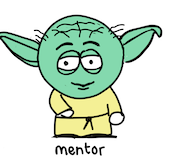
Things to try…
- Offer individual mentoring sessions. Coaching and mentoring are two sides of the same coin. Based on the preference of your team members, something can become coaching (focus on asking questions that help the team gain new insights) or mentoring (sharing personal experiences, knowledge, and ideas).
- Organize a virtual User Experience Fishbowl. The Liberating Structures UX Fishbowl is ideally suited to tap into the expertise and experiences of “the crowd”. Pick a relevant topic (e.g. how to effectively work together remotely). Invite 5–7 experienced people from in- or outside the organization, they become the “inner circle”. The inside circle shares experience based around a common challenge while the outer circles listen. In alternating rounds, the outer circles generate questions they’d like to ask the inside circle. The UX Fishbowl helps create an environment where people can learn together, rather than get solutions imposed on them.
- Join public virtual meetups. Instead of organizing your own meetups, you can also join a public meetup. Finding a meetup shouldn’t be a problem. Given the overwhelming amount of meetups, finding the right meetup can be more challenging. As a Scrum Master, do some research and compile a shortlist. Ask your team to pick one meetup and attend it together. To point you in an interesting direction: almost every country has its own Liberating Structures User Group(s).
- Host a virtual Troika Consulting session. The Liberating Structure Troika Consulting is both coaching & mentoring. In this article, Boris Steiner describes it in detail. Organize a bi-weekly or monthly session within your team or entire organization to encourage giving & getting help with the challenges people are facing. Troika Consulting enables the exchange of thoughts, experiences, and ideas on how to handle problems and challenges.
- Reach out to other Scrum Masters. Given the global spread of the COVID-19 virus, Scrum Masters around the world are facing similar challenges. Sure, there will be local differences. But how to fulfill your Scrum Master role effectively and successfully will most likely be in everyone’s mind nowadays. Make use of today's technology and reach out to other Scrum Masters. Let’s learn and grow, together!
Remote Facilitation
The Scrum Master facilitates the empirical process of Scrum by helping teams find the best way to make work transparent and to inspect and adapt. The Scrum Events are excellent opportunities to spark the necessary cross-functional and self-organizing capabilities of the team.
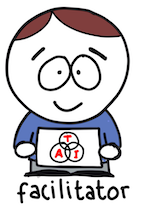
Things to try…
- Keep the rhythm of the Scrum Events. Especially when working remotely, having a clear structure, process and rhythm are important. Organize a session with your Scrum Team and discuss the preferred Sprint rhythm. Reconsider the time-boxes of the various Scrum Events. Especially with virtual events, shorter is better.
- Facilitate all the Scrum Events. As a Scrum Master, you don’t have to facilitate all the Scrum Events yourself. For example, the Daily Scrum is attended by the Development Team only. While conducting virtual events is most likely a new experience, offer the Development Team and Product Owner to help out with facilitation. As such, they can focus on the conversation and don’t have to worry about how to use new technology. Leave the facilitation to the team whenever they feel comfortable about it.
- Read the article “10 tips to have productive and engaging virtual meetups”. Tips we can’t emphasize enough are: start your sessions always with a personal connection, make it interactive (with Liberating Structures), break down your interactions in smaller groups, create a digital workspace to collect insights, and use short time-boxes & frequent breaks.
- Facilitate transparency, inspection, and adaptation (TIA). The Scrum Master needs to support the team in finding the best way of making their work transparent and to inspect and adapt. When working remotely, this can require the team to use a completely different approach. What if the Product- and Sprint Backlog used to be only available on a physical wall in the office? How can you host a Sprint Review in which stakeholders, the Product Owner, and the Development Team work together to inspect the increment and determine the next steps? How can you make team morale transparent? How to create transparency about the team’s collaboration? TIA remains the core behind the empirical process of Scrum. Working remotely requires all your skills as a Scrum Master to keep it successful!
Remote Change Agent
The Scrum Master as a change agent helps organizations as a whole work more effectively with Scrum. This requires collaboration with other Scrum Masters, Product Owners, and stakeholders.

Things to try…
- Organize a virtual meetup with “Future~Present”. The Liberating Structure “Future~Present” (which is still in development) invites groups to travel to a successful future and tell the story of what that required in the present, while also appreciating what will grow into the success of tomorrow. The invitation for this meetup could be “We find ourselves 25 years in the future. We have successfully dealt with the COVID-19 crisis.” In small groups, trigger the conversation with questions like “What was it like in the midst of this turmoil? How did you feel? What gave you hope amid the despair?
- Reflect on the Scrum Framework poster with “What, So What, Now What”. In a digital workspace, upload the poster of the Scrum Framework. Together with your Scrum Team, use the Liberating Structure “What, So What, Now What” to guide the reflection. Offer questions like: “Given our current way of remote working and dealing with the COVID-19 crisis, what do we notice about how we apply Scrum? Based on the facts, what does this mean? What conclusions can we draw? Now, what next steps make sense? What do we need to change in how we use the Scrum framework?”
- Use “Ecocycle Planning” during a Sprint Retrospective. This Liberating Structure brings clarity in your activities as a Scrum Team and helps to identify where your energy and time you should go. Given the new circumstances, what are activities you should invest more time in? What are activities that used to be valuable, but nowadays are not? What are the relationships you need to reconsider? Using Ecocycle Planning will help the Scrum Team analyze the full portfolio of activities and relationships to identify obstacles and opportunities for progress.
- Organize a virtual Strategy Knotworking workshop. Strategy Knotworking is a coherent set of Liberating Structures that aims to involve and engage everyone in developing and evolving sustainable strategies on all levels of an organization. This article describes how we used it for The Liberators. Use it as inspiration for your own workshop in which the Scrum Team explores the six core questions.
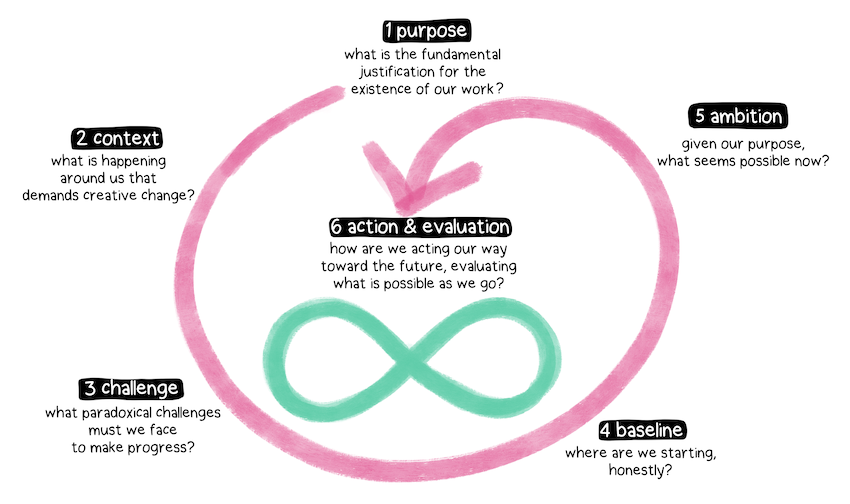
The 6 core questions of Strategy Knotworking (illustration by Thea Schukken)
Remote Servant Leadership
Scrum Masters are servant leaders. Servant leadership is an ever-present mindset and attitude by which you fulfill all the other stances. Scrum Masters recognize that in complex work, bringing people together and shaping future actions together is the best way to be effective.

Things to try…
- Show vulnerability and create a safe environment. Be open about problems, personal issues, or anxiety. During the Daily Scrum, make space for sharing personal stories as well. This lowers the barrier for others to be open as well. Create an environment where constructive disagreement about challenges is encouraged.
- Show empathy and compassion. Developing empathy and compassion for others is vital. By understanding the pains and gains of others, we can often see initial resistance or worries in a new light. The possible sudden change in working remotely will have a different impact on everyone. For example, when you need to educate 3 children at home, this will result in distraction during the day. Try to support each other with this new situation.
- Trust the team. Having the entire teamwork remotely is an excellent opportunity to challenge your inner control-freak. Resist the temptation for task-oriented control. Encourage the team to set Sprint- and Daily Goals and use the stances of coaching & impediment remover to support them.
- Have a virtual lunch together. Once or twice during the week, agree to have lunch together. Don’t discuss only work stuff, keep it personal, bring up topics about new movies, series, books, etc. Make it something that helps improve team dynamics and morale.
- Re-assess the Agile Manifesto. The change to working remotely can shift the focus to processes & tools, comprehensive documentation, contract negotiation, and following a plan. In uncertainties and difficult times, organizations often respond by taking tight control and focusing on the “tangible parts & guarantees” (the right side of the Agile Manifesto). This will backfire ruthlessly and hurt trust. As a servant-leader, help the organization find a good balance between setting up new tools & processes that support interactions & collaboration. Keep focusing on working software and maintain a good relationship with your stakeholders.
Closing Words
In this article, we included many experiments, practices, and strategies for being a remote Scrum Master. Using the stances of a Scrum Master as a structure, we offered ideas on how to teach, facilitate, coach, mentor, remove impediments, be a change agent, and show servant-leadership. All of these ideas can be applied in-person as well.
If you’ve got any ideas yourself as well, let us know. We’d love to learn from you as well! Working together, we have the creativity, intelligence, and wisdom to overcome the many hard challenges that we face in helping organizations work effectively (remotely) with Scrum.
Join our community on The Liberators Network! Or, join our virtual Scrum.org PSM II class. We organize one in June. Check this registration page for more information.

See how you can support us at patreon.com/liberators
